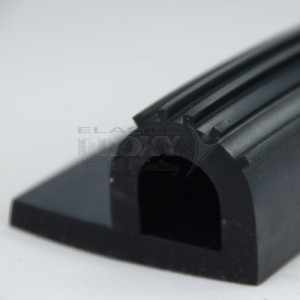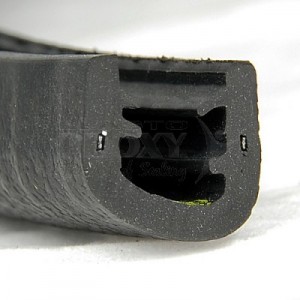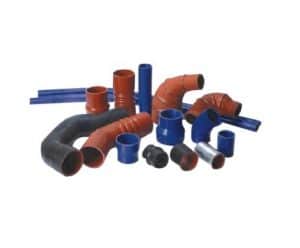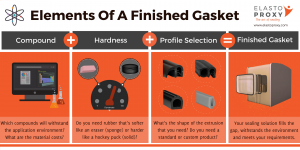
When is EPDM rubber the right choice for sealing and insulation? EPDM seals and gaskets are used widely with vehicles and equipment, but this synthetic elastomer has unsatisfactory resistance to gasoline, diesel fuel, and motor oil. EPDM’s advantages are numerous, however, and this cost-effective compound is often a better choice than silicones – especially in outdoor environments.
If you’re wondering whether EPDM is the right choice for your sealing and insulation application, Elasto Proxy invites you to take a closer look at this M-class elastomer. The M in M-class indicates that EPDM is part of ASTM D1418, a common specification for characterizing rubber compounds. Often, design or product engineers use ASTM specs to designate the rubber material on a part drawing.
In this article, we’ll examine EPDM’s advantages and applications. We’ll also consider its disadvantages – and consider how EPDM rubber compares to some other materials. Finally, we’ll look at how EPDM is supplied and fabricated.
EPDM Advantages
 Ethylene propylene diene monomer (EPDM) is a compound that resists sunlight, ozone, oxygen, aging, acids, alkalis, water, and severe weather conditions. This odor-free elastomer also provides excellent color stability and high heat resistance. Depending on the compound’s chemistry, service temperatures can range from -70° C to 250° C. All EPDM rubber isn’t the same, so differences in ethylene content and the dienes that are used can affect physical properties.
Ethylene propylene diene monomer (EPDM) is a compound that resists sunlight, ozone, oxygen, aging, acids, alkalis, water, and severe weather conditions. This odor-free elastomer also provides excellent color stability and high heat resistance. Depending on the compound’s chemistry, service temperatures can range from -70° C to 250° C. All EPDM rubber isn’t the same, so differences in ethylene content and the dienes that are used can affect physical properties.
EPDM rubber also provides good-to-high tensile strength and elasticity. Tensile strength, the resistance of a material to breaking under tension, is often measured in pounds per square inch (PSI). Typical EPDM values are in the 1000 PSI range. Elasticity, a measure of a material’s ability to resume its normal shape after being stretched or compressed, is expressed as a percentage. With EPDM, this percentage is typically in the 300% range. Most EPDM rubber has a durometer, or hardness, of 40 to 90 (Shore A).
EPDM Applications
With its strong combination of thermal and mechanical properties, EPDM is a good choice for the door and window seals used with mobile equipment. These rubber gaskets seal out wind, water, dust, mud, and a range of outdoor temperatures. EPDM gaskets also provide a measure of acoustic insulation against road noise and equipment sounds. Additional vehicle applications include hood seals. EPDM’s strength and elasticity also make it a good choice for the vibration isolation mounts used with machinery.
For bus, subway, and rail manufacturers, certified-transit grade (CTG) seals made from a special EPDM rubber can meet specific flame, smoke, and toxicity (FST) requirements. Indoors, EPDM rubber is used for applications where there’s contact with hot and cold water or saturated steam. Examples include refrigerator and freezer gaskets, dust boots, and rubber pipe sleeves. With its resistance to vibration and support for thermal expansion and contraction, EPDM is also a good choice for HVAC gaskets.
EPDM Disadvantages
EPDM’s main disadvantage is its unsatisfactory resistance to certain categories of chemicals. In addition to gasoline, diesel fuel, and motor oil, EPDM is not recommended for use with synthetic diester oils, lubricants found in some types of industrial machinery. EPDM also provides unsatisfactory resistance to Freon, a category of fluorocarbons that are used as refrigerants. Before selecting an EPDM compound, it’s important to check for chemical compatibility.
EPDM Comparisons
EPDM is often used instead of silicones, nitrile, or thermoplastic elastomers (TPEs). Silicones can withstand lower and higher temperatures, but they lack EPDM’s resistance to abrasion, cutting, and tearing. EPDM also provides better tensile strength than silicone rubber. For applications that require resistance to fuels, greases, and oils, nitrile is a better choice than EPDM. For applications that require recyclable materials, engineers can choose TPEs.
EPDM Rubber and Custom Fabrication
EPDM sheets and profiles support custom fabrication via manufacturing methods such as water jet cutting, lamination, gasket taping, and parts marking. They are available in standard and special grades, and can be supplied as solid, sponge, and foam materials. Examples of specialty materials include EPDM that meets FDA, UL 94, or NSF standards.
To learn more about EPDM rubber and whether it’s the right choice for your sealing and insulation application, contact Elasto Proxy.











